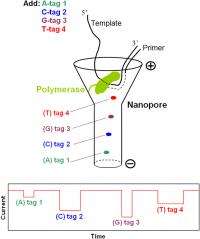Researchers report novel approach for single molecule electronic DNA sequencing

(Phys.org)—DNA sequencing is the driving force behind key discoveries in medicine and biology. For instance, the complete sequence of an individual's genome provides important markers and guidelines for medical diagnostics and healthcare. Up to now, the major roadblock has been the cost and speed of obtaining highly accurate DNA sequences. While numerous advances have been made in the last 10 years, most current high-throughput sequencing instruments depend on optical techniques for the detection of the four building blocks of DNA: A, C, G and T. To further advance the measurement capability, electronic DNA sequencing of an ensemble of DNA templates has also been developed.
Recently, it has been shown that DNA can be threaded through protein nanoscale pores under an applied electric current to produce electronic signals at single molecule level. However, because the four nucleotides are very similar in their chemical structures, they cannot easily be distinguished using this technique. Thus, the research and development of a single-molecule electronic DNA sequencing platform is the most active area of investigation and has the potential to produce a hand-held DNA sequencer capable of deciphering the genome for personalized medicine and basic biomedical research.
A team of researchers at Columbia University, headed by Dr. Jingyue Ju (the Samuel Ruben-Peter G. Viele Professor of Engineering, Professor of Chemical Engineering and Pharmacology, Director of the Center for Genome Technology and Biomolecular Engineering), with colleagues at the National Institute of Standards and Technology (NIST) led by Dr. John Kasianowicz (Fellow of the American Physical Society), have developed a novel approach to potentially sequence DNA in nanopores electronically at single molecule level with single-base resolution. This work, entitled "PEG-Labeled Nucleotides and Nanopore Detection for Single Molecule DNA Sequencing by Synthesis" is now available in the open access online journal, Scientific Reports, from the Nature Publication group.
The reported nanopore-based sequencing by synthesis (Nano-SBS) strategy can accurately distinguish four DNA bases by detecting 4 different sized tags released from 5'-phosphate-modified nucleotides at the single molecule level for sequence determination. The basic principle of the Nano-SBS strategy is described as follows. As each nucleotide analog is incorporated into the growing DNA strand during the polymerase reaction, its tag is released by phosphodiester bond formation. The tags will enter a nanopore in the order of their release, producing unique ionic current blockade signatures due to their distinct chemical structures, thereby determining DNA sequence electronically at single molecule level with single base resolution. As proof-of-principle, the research team attached four different length polymer tags to the terminal phosphate of 2'-deoxyguanosine-5'-tetraphosphate (a modified DNA building block) and demonstrated efficient incorporation of the nucleotide analogs during the polymerase reaction, as well as better than baseline discrimination among the four tags at single molecule level based on their nanopore ionic current blockade signatures. This approach coupled with polymerase attached to the nanopores in an array format should yield a single-molecule electronic Nano-SBS platform.
In previous work, the Center of Genome Technology & Biomolecular Engineering at Columbia University, led by Professor Ju and Dr. Nicholas J. Turro (William P. Schweitzer Professor of Chemistry), developed a four-color DNA sequencing by synthesis (SBS) platform using cleavable fluorescent nucleotide reversible terminators (NRT), which is licensed to Intelligent Bio-Systems, Inc., a QIAGEN company. SBS with cleavable fluorescent NRTs is the dominant approach used in the next generation DNA sequencing systems. Dr. Kasianowicz and his group at NIST pioneered the investigation of nanopores for single molecule analysis. They previously reported that different length polymers, polyethylene glycols (PEGs), could be distinguished by their unique effects on current readings in a α-hemolysin protein nanopores at single molecule level and subsequently developed a theory for the method. Their results provide the proof-of-concept for single molecule mass spectrometry. The combination of the SBS concept with the distinct nanopore-detectable electronic tags to label DNA building blocks led to the development of the single-molecule electronic Nano-SBS approach described the current Scientific Reports article.
As lead author Dr. Shiv Kumar points out, "The novelty of our approach lies in the design and use of four differently tagged nucleotides, which upon incorporation by DNA polymerase, release four different size tags that are distinguished from each other at the single molecule level when they pass through the nanopore. This approach overcomes any constraints imposed by the small differences among the four nucleotides, a challenge which most nanopore sequencing methods have faced for decades." Moreover, the technique is quite flexible; with PEG tags as prototypes, other chemical tags can be chosen to provide optimal separation in different nanopore systems.
With further development of this Nano-SBS approach, such as the use of large arrays of protein or solid nanopores, this system has the potential to accurately sequence an entire human genome rapidly and at low cost, thereby enabling it to be used in routine medical diagnoses.
More information: Scientific Reports, 2, 684 DOI:10.1038/srep00684, 2012
Journal information: Scientific Reports
Provided by Columbia University

















